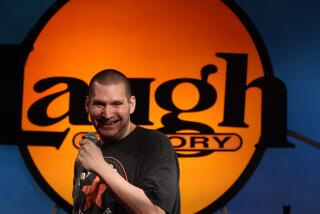Power to the Playful : Laughter Heals, Say Psychologists at Fun-Filled Conference
- Share via
Matt Weinstein, the self-styled “Master of Playfulness,” was there. So was Vera Robinson, “The Fairy Godmother of Humor in Nursing.” And so was Allen Klein, “The King of Whimsy” and publisher of the Whole Mirth Catalog.
They had come to Long Beach, along with a dozen other psychologists, doctors and consultants, to hoe the rich soil of one of pop psychology’s favorite fads: teaching people how to be systematically playful in a world that tends to grind them into overly serious, burned-out men and women.
The fourth annual conference on “The Power of Laughter and Play,” held on the Queen Mary last weekend, drew 1,000 people, mostly counselors, nurses and other health professionals, who paid $198 for three days of speakers and workshops.
The conference was a swirl of joke-telling, juggling, hugging, paper hat-wearing, face-painting and more serious lectures on what many health experts see as a connection between laughter and disease prevention.
It was also an illustration of how a principle based on common sense--”laughter is the best medicine”--can flower into a myriad of gimmicks, techniques and subspecialists.
At one end of the spectrum were nationally known physicians such as O. Carl Simonton, a Pacific Palisades oncologist who claims longer survival rates for cancer patients who practice his visualization technique of imagining their white blood cells attacking and devouring cancer cells.
Simonton, one of the most respected proponents of the power of mental healing, says he could not have continued working with cancer patients this long if he had not forced himself to set aside time for playful activities like drumming or juggling.
At the other end of the spectrum were lesser-known but even more zealous figures like Annette Goodheart, a Santa Barbara painter-turned-psychologist with a nonstop throat-to-belly laugh who carries a teddy bear and urges people to “laugh 500 times a day if you can” on the theory that laughter is healthful “internal jogging.”
People who showed up in search of learning how to be more playful could wander in and out of workshops that taught them, in Weinstein’s parlance, how to “design playful experiences”; or how to “laugh your way to health,” as Goodheart titled hers; or how to “take the playful child home,” in the words of another speaker, Erin Sommerville, a staff member of the sponsoring institute, the Northern California-based Institute for the Advancement of Human Behavior.
There were how-to’s on creating different types of jokes, giving different types of hugs and making a hospital more amusing by pushing a “laugh cart,” which carries things like water pistols, joke books and toys through the wards.
It made for a weekend full of sincere embraces, laughter and cheerful conversation. A reporter with an unfashionably serious expression on his face, waiting to interview a speaker, was approached by a young woman with an infectious smile who asked, “Are you in need of a hug?”
More difficult to discern, however, was the question of how much long-term good is accomplished by such conferences--and the larger question of whether humor or playfulness can be taught in the first place.
Called a Contradiction
Harvey Mindess, director of the psychology department of Antioch University’s Los Angeles campus and the author of several books on humor, said the idea of attempting to teach people to laugh more is “a contradiction in terms.”
“Humor should be a spontaneous occurrence, not planned out,” said Mindess, who is not a member of the institute that sponsored the conference and did not attend. “Telling jokes or having a pre-planned idea that you’re going to use humor today--that’s not what I propose.”
Some speakers at the conference, like Joel Goodman, who runs The Humor Project at a Saratoga Springs, N.Y., institute, argued in favor of calculated humor to keep up the weekend’s momentum.
Goodman, who publishes the quarterly Laughing Matters, a compendium of jokes, puns and suggestions for creating more of them, told audiences at his workshops to conscientiously find up to 15 laughs a day--either in life’s own events or by making up.
The goal, he said, is to create “inverse paranoids--those who think the world is out to do them good.”
The most that can be taught to people, Mindess said, is “to recognize that their sense of humor is a valuable part of them and they shouldn’t squelch it. The spirit of humor is to get loose, to allow yourself to be uninhibited, to let things come out uncensored.
“A lot of people as they become adults lose the sense of humor they had as children or adolescents. A lot of them get the message that if you’re a serious, dignified adult, holding down a job and all that crap, you don’t fool around. . . . They take the business of life seriously, they lose or squelch their sense of humor or only keep it for when they go home or have a couple of drinks. They should use it in their daily life.”
Signs of Growth
The variety of consultants at the Long Beach conference was typical of how the “humor movement” in psychology has grown in the last decade and a half, Mindess said. “It has a lot of validity, and it has some parts which are just airy,” he said.
Conference participant Simonton agreed. “In general, the human potential movement has been focused toward the short-term and more gimmicky things,” he said. “I think that’s the nature of the beast. This happens any time you get anything into the fad category, which this has become.”
However, Simonton said he is not bothered by the systematic instruction of playfulness. He said many people in stressful professions become emotionally burned out and capable of relaxing only if they force themselves to make time for play the same way they make time for a business deal.
He said his own experience is typical. Only when a supervising psychiatrist pointed out to him that he was working too hard in the early 1970s--”killing myself by the imbalance between work and play”--did he begin changing his life, Simonton said in an interview.
Depressing Work
“My work is primarily dealing with people with advanced cancer. It is heavy, depressing work. . . . I tend to be, like most professional people, a compulsive, over-achieving workaholic,” he said. “I had a psychiatrist for whom I had great respect tell me that by not playing, I was not being as creative as I would have been if I’d had time to play and enjoy myself. He relabeled play as ‘work,’ knowing I was compulsive. It was honorable to work. It was not honorable to play. I couldn’t justify taking the time. He pointed out to me that I had to relabel it.”
Many speakers at the conference brought with them a rock-solid belief that laughter staves off disease by stimulating respiration and circulation, relaxing muscle tension and increasing the body’s built-in pain-killing mechanisms. They have extended this philosophy to make claims that a positive attitude stamped by laughter and playfulness can prevent diseases such as cancer, arthritis, allergies and heart attacks.
However, a study published last year in the New England Journal of Medicine concluded that there was no relationship between attitudes and survival or recurrence of cancer for 359 cancer patients. The study was billed by its sponsors as the first methodologically sound investigation of the relationship between psychosocial factors and survival in advanced malignant disease.
More to Read
Sign up for Essential California
The most important California stories and recommendations in your inbox every morning.
You may occasionally receive promotional content from the Los Angeles Times.










